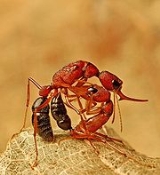
Harpegnathos
Encyclopedia
Harpegnathos is a basal
genus of ant
s. This ponerine ant has a different colony structure compared to other genera. In the beginning, young winged queens fly out from their natal colony, mate with foreign males and start new colonies independently. What differs from other ants is that, once the founding queen dies (after a few years), several daughter workers replace her as reproductives in the colony. It is characteristic of several ponerine species that workers can mate (almost always with foreign males) and store sperm in the spermatheca. In Harpegnathos saltator
, many young workers inbreed with males from the same colony (their brothers). They fight to establish a dominance hierarchy, and a few high-rankers will become reproductives and lay eggs, so-called gamergates. Every year, new winged queens will be reared, and they will disperse and start the process again. The combination of queen and gamergate reproduction results in an increased lifespan of colonies.
Basal (phylogenetics)
In phylogenetics, a basal clade is the earliest clade to branch in a larger clade; it appears at the base of a cladogram.A basal group forms an outgroup to the rest of the clade, such as in the following example:...
genus of ant
Ant
Ants are social insects of the family Formicidae and, along with the related wasps and bees, belong to the order Hymenoptera. Ants evolved from wasp-like ancestors in the mid-Cretaceous period between 110 and 130 million years ago and diversified after the rise of flowering plants. More than...
s. This ponerine ant has a different colony structure compared to other genera. In the beginning, young winged queens fly out from their natal colony, mate with foreign males and start new colonies independently. What differs from other ants is that, once the founding queen dies (after a few years), several daughter workers replace her as reproductives in the colony. It is characteristic of several ponerine species that workers can mate (almost always with foreign males) and store sperm in the spermatheca. In Harpegnathos saltator
Harpegnathos saltator
Harpegnathos saltator, sometimes called Jerdon's jumping ant, is a species of ant found in India. They have long mandibles and have the ability to leap a few inches. They are large eyed and are active predators that hunt mainly in the early morning hours...
, many young workers inbreed with males from the same colony (their brothers). They fight to establish a dominance hierarchy, and a few high-rankers will become reproductives and lay eggs, so-called gamergates. Every year, new winged queens will be reared, and they will disperse and start the process again. The combination of queen and gamergate reproduction results in an increased lifespan of colonies.

